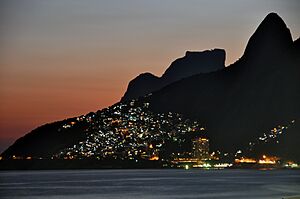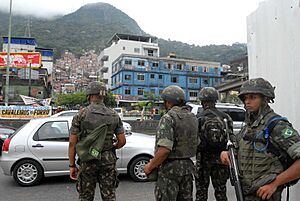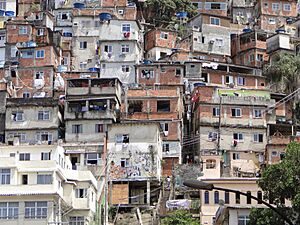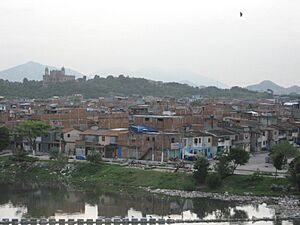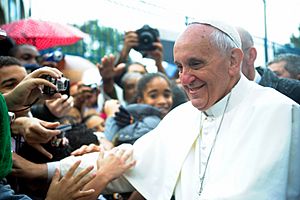Favela facts for kids
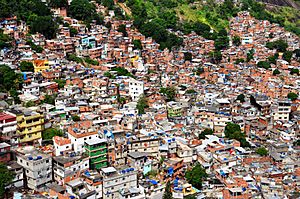

A favela (pronounced fa-VEH-la) is a special name for certain working-class neighborhoods in Brazil. The word means a slum or ghetto. It was first used in the late 1800s in a place called the Slum of Providência in Rio de Janeiro. This area was built by soldiers who had nowhere to live after a war. They had lived near favela trees in another part of Brazil.
Some of the first settlements were called bairros africanos, meaning "African neighborhoods." Over time, many formerly enslaved Africans moved into these areas. Even before the first favelas, poor people were often pushed out of cities. They had to live in far-off suburbs.
Most modern favelas grew in the 1970s. This happened because many people moved from farms to cities, a trend called rural exodus. They could not find affordable homes. So, many ended up living in favelas. In 2010, about 6% of Brazil's population lived in favelas or similar areas. Favelas are found in 323 of Brazil's 5,565 cities.
Contents
History of Favelas
The word "favela" comes from the late 1800s. Soldiers from a war in Bahia state came to Rio de Janeiro. They had no place to live. In Bahia, these soldiers knew a place called Morro da Favela ("Favela Hill"). This name came from the favela tree, which can irritate the skin. When the soldiers settled on a hill in Rio, they called it "Favela hill."
Favelas formed before cities became very crowded. After slavery ended and more people moved to Brazilian cities, many from the countryside came to Rio. These new people looked for work. But with little money, they could not afford city housing.
By the 1920s, favelas had grown a lot. People started to see them as a problem for society. The word "favela" became an official term for poor settlements on hills. In 1937, a building law officially recognized favelas. This was the start of government policies about them.
In the 1940s, there was a housing crisis. Poor city dwellers built many shantytowns in the suburbs. Favelas became the main type of home for poor people in Rio. Favelas grew very fast from the 1940s to the 1970s. This was when Getúlio Vargas's plan to build industries brought many people to Rio. Shantytowns then spread beyond Rio into the areas around the city.
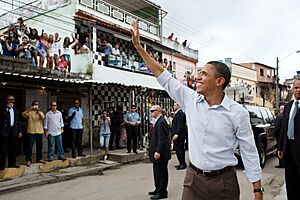
In the 1950s, more people moved from the countryside to cities across Brazil. They hoped to find jobs and a better life. But those who moved to Rio de Janeiro picked a difficult time. Brazil's capital moved from Rio to Brasília in 1960. This caused jobs and industries in Rio to slowly disappear. People could not find work, so they could not afford homes in the city. They stayed in the favelas. Even though favelas were close to Rio, the city did not provide services like water, electricity, or trash collection. Favelas soon became linked with extreme poverty. Many people and politicians in Rio saw them as a problem.
In the 1970s, Brazil's military government tried to get rid of favelas. This forced hundreds of thousands of people to move. During Carlos Lacerda's time as governor, many people were moved to public housing projects. One example is Cidade de Deus ("City of God"), which later became famous in a movie. But poor planning and not enough money from the government caused these projects to become new favelas.
Some favelas in Rio are still controlled by organized groups. But many favelas in Rio's South Zone and key ones in the North Zone are now managed by Pacifying Police Units, called UPPs. Rio's leaders say UPPs are a new way to bring government presence to these areas.
Most current favelas really grew in the 1970s. A building boom in rich parts of Rio de Janeiro brought many workers from poorer states in Brazil. Since then, new favelas have formed in similar ways.
Communities in favelas grow over time. They often create groups to get services like running water and electricity. Sometimes, residents can even get legal ownership of their land. This helps them improve their homes. Because of crowding and poor conditions, diseases are common in poorer favelas. Also, favelas on hillsides are often at risk from floods and landslides.
| Services in Favelas (2010) | Percent |
|---|---|
| Sanitation | 67.3 |
| Water | 88.3 |
| Electricity | 99.7 |
| Garbage collection | 95.4 |
| People in Favelas | Population |
| Favela residents in Brazil | 11,400,000 (6%) |
| Favela Demographics | Proportion |
| Mixed-race or Black | 68.4 |
| Cannot read or write | 8.4 |
Government Policies for Favelas
In the late 1800s, the government allowed soldiers to settle on Providência hill in Rio. This led to the first squatter settlement. More people, including former enslaved Black people, joined this settlement. It became known as Morro de Providência. The first government actions came because of overcrowding and disease outbreaks. At the same time, many White Europeans moved to the city. This created a high demand for housing near the water. The government responded by tearing down slums and moving people to other parts of Rio. This was the start of nearly a century of strong government actions, often involving forced removal.
In the early 1900s, favelas were seen as places where bad behavior and diseases spread. People living in favelas were often not treated fairly in legal matters. However, this began to change. For example, a family from Morro da Cyprianna favela took a slander case to court. This showed a shift in how favela residents were viewed by the public.
After the first forced moves, the government mostly left favelas alone until the 1940s. During this time, politicians pushed for public housing. They said it would help with poverty and industrial growth. The "Parque Proletário" program moved favela residents to temporary homes. The idea was to clear land for permanent housing. But the new homes were never built. The temporary housing areas grew into new, larger favelas. Some say this program set the stage for the stronger removal policies of the 1960s and 1970s.
Many people moved to Rio de Janeiro in the 1950s. This caused favelas to spread across the city. To deal with the "favela problem," the government started a large-scale removal program in the 1960s and 1970s. Favela residents were moved to the edges of the city. During this time, some of the harshest favela removals in Rio's history happened. The military government provided little help for people to adjust to their new homes.
In the 1980s and early 1990s, government policy changed. Instead of removing favelas, the focus was on improving them. The "Favela-Bairro" program, started in 1993, aimed to make life better for favela residents. It provided basic services like sanitation and social support. It also connected favelas to the city with new streets and public spaces. And it helped residents get legal ownership of their land. However, strong government actions did not completely stop. Violence in favelas was increasing. From 1995 to mid-1995, the state approved a joint army-police action called "Operação Rio." This was the government's attempt to regain control of the favelas.
Since 2009, Rio de Janeiro has built walls between rich neighborhoods and favelas. Officially, these walls protect nature. But some critics say they are for keeping different economic groups separate.
Pacifying Police Units
Starting in 2008, special police groups called UPPs (Pacifying Police Units) began working in many favelas in Rio de Janeiro. This program was led by the State Public Security Secretary, José Mariano Beltrame, with support from Governor Sérgio Cabral.
Rio's governor, Sérgio Cabral, visited Colombia in 2007. He wanted to learn about their public safety improvements. After returning, he got US$1.7 billion to improve security in Rio, especially in favelas. In 2008, the state government created the UPP police force. New recruits get special training and a monthly bonus. By October 2012, UPPs were in 28 favelas. The government's goal was to have 40 UPPs by 2014.
To start a UPP in a favela, Rio de Janeiro's special police unit, BOPE, first moves in. Their job is to arrest or drive out gang leaders.
Many people in favelas do not trust the police. So, working from inside the community is more effective. A 2010 report noted that the murder rate in Rio's favelas had dropped. The report also stressed the importance of programs that combine police work with community efforts.
Journalists studying the 2012 city elections found something interesting. People living in favelas with UPPs voted for more different candidates. This was different from areas controlled by organized groups.
More recent government policies are different from the past. Now, community policing and involving residents in planning are key parts of Brazilian policy. The "Favela Chic" program aimed to bring favelas into the city's social life. It also wanted to help favela residents become important leaders in their communities. However, some news outlets have criticized this change. They believe it only happened because Rio was getting a lot of media attention for the 2014 FIFA World Cup and the 2016 Olympic Games. Critics also pointed out that while the government talked about good intentions, some actions were still harsh. For example, in 2010, Rio's Mayor Eduardo Paes announced the removal of two favelas, Morro de Prazeres and Laboriaux, and forced their residents to move.
Favela policies have changed a lot over the last century. In 2020, a police report showed that Rio de Janeiro had 1,413 favelas. All of them were controlled by armed groups outside of government control. Because these informal settlements are so large and complex, many experts continue to study them.
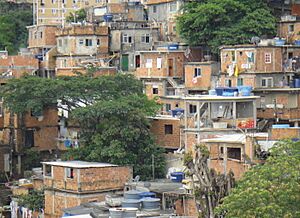
Favela Life and Culture
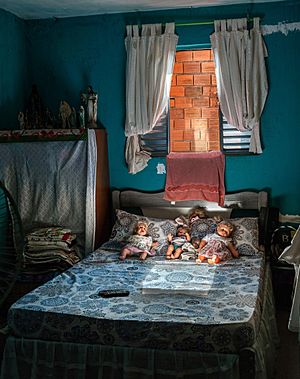
People who live in favelas are called favelados. Favelas are often linked to poverty. Brazil's favelas exist because wealth is not shared equally in the country. Brazil is one of the most unequal countries. The richest 10% of people earn half of the country's income. About 8.5% of all people live below the poverty line. Because of this, favela residents often face unfair treatment. They can experience inequality and exploitation. This negative view of people from favelas can make it hard for them to find jobs.
The Brazilian government has tried to improve urban poverty in the 20th century. One way was by removing favelas and their residents in the 1970s. This happened when Brazil was under military rule. These programs forced over 100,000 people to move. They were placed in public housing or sent back to the countryside. Another attempt to deal with poverty was through gentrification. The government tried to improve favelas and connect them to the city. As these "improved favelas" became more stable, they attracted middle-class people. This pushed the original favela residents out. They ended up on the streets or in suburbs far from jobs and opportunities. For example, in Rio de Janeiro, most homeless people are Black. This is partly due to favela gentrification and people being forced out.
Growth and Changes in Favelas
Even though there were efforts to remove favelas from big Brazilian cities like Rio de Janeiro and São Paulo, the number of poor people grew fast. So did the modern favelas they lived in by the end of the last century. This growth is called "favelização" (favela growth). In 1969, Rio de Janeiro had about 300 favelas. Today, it has twice that many.
In 1950, only 7% of Rio de Janeiro's people lived in favelas. Today, this number has grown to 19%, or about one in five people. From 1980 to 1990, Rio's overall population growth slowed by 8%. But the favela population increased by 41%. After 1990, the city's growth rate stayed at 7%. But the favela population still grew by 24%. However, a 2010 report showed that Brazil has reduced its slum population by 16%. Now, about 6% of the country's total population lives in slums.
Religion in Favelas
Many different religions are found in favelas. In the past, Catholicism was the most common religion. But over the last few decades, more people have become Evangelical Christians, including Pentecostalism. While more people are converting to Evangelicalism, there are also more people who say they are not religious.
Music in Favelas
Popular types of music in favelas include funk, hip-hop, and Samba. Recently, funk carioca, a type of music from the favelas, has become popular worldwide. This music often uses parts of other songs. Popular funk artists include MC Naldo and Buchecha. Bailes funk are dance parties that play this type of funk music. They became popular in favelas. The famous hip-hop artist MV Bill is from Cidade de Deus in Rio de Janeiro. Favela Brass is a free music school in Pereirão, Rio. It aims to give children opportunities through music.
Favela Culture Becomes Popular
Media like movies and TV shows also help spread knowledge about favelas. This has led to more interest in favelas as places for tourists to visit. In recent years, favela culture has become popular as inspiration for art around the world. People's interest in favela life can be seen in paintings, photos, and models of favela homes. There have even been nightclubs in Europe inspired by favelas.
Favela Tourism
Since the mid-1990s, a new kind of tourism has grown in cities around the world. These are cities in what are called "developing" or "emerging" countries. This tourism involves visiting the poorest parts of a city. It mostly consists of guided tours, run by companies, through these areas. This new type of tourism is often called slum tourism. It can also be seen in places like South Africa and India.
In Brazil, this growing tourism market has developed in a few specific favelas. Most are in Rio de Janeiro and São Paulo. The largest and most visited favela for tourism is Rocinha. This new type of tourism has become a major part of exploring these cities.
There are different opinions on whether favela tourism is a good idea. These tours can help people learn about the needs of the poor people living in favelas. They also give tourists a look at a part of Rio that is often hidden. The tours are seen as a unique alternative to famous Rio attractions. These include Sugarloaf Mountain and Christ the Redeemer. They offer a quick look at Rio's hillside communities. For example, there are tours of the large favela of Rocinha. Trained guides drive tourists up the favela in vans. Then, they explore the hillside on foot. Guides walk groups down main streets and point out local spots. Most tours stop at a community center or school. These places often get money from the tour profits. Tourists can talk with local people, leaders, and officials. This helps them understand favela life. Some tour companies allow pictures in certain areas, while others do not allow any pictures.
Some things you might see on these tours include:
- Explanations about how different areas within a favela are priced (like rent and property).
- Information about modern services like Wi-Fi and health clinics.
- Details about shopping and services like fashion stores and cafes.
- Meetings with volunteers working on social or cultural projects.
- Visits to schools, kindergartens, or other places for children.
- A look inside private homes and chances to talk with residents.
- A visit to a local restaurant or cafe.
The Brazilian government thinks highly of favela tourism. The government of Luiz Inácio Lula da Silva started a program to bring more tourism into favela economies. The Rio Top Tour Project began in August 2010. It promotes tourism throughout Rio de Janeiro's favelas. It started in Santa Marta, a favela with about 5,000 residents. The government provided money to boost tourism there. They spent 230 thousand Reais (about US$145 thousand) on the project in Santa Marta. English signs show where attractions are. Samba schools are open, and viewing spots have been built for tourists to enjoy Rio's views. Government officials are also doing marketing and building information booths for visitors. Residents have been trained to be tour guides, following existing favela tour programs. Recently, favelas have been shown in many movies and video games. This media attention has increased people's interest in favelas as tourist spots.

See also
 In Spanish: Favela para niños
In Spanish: Favela para niños
|
|
|
|
Favelas
|


